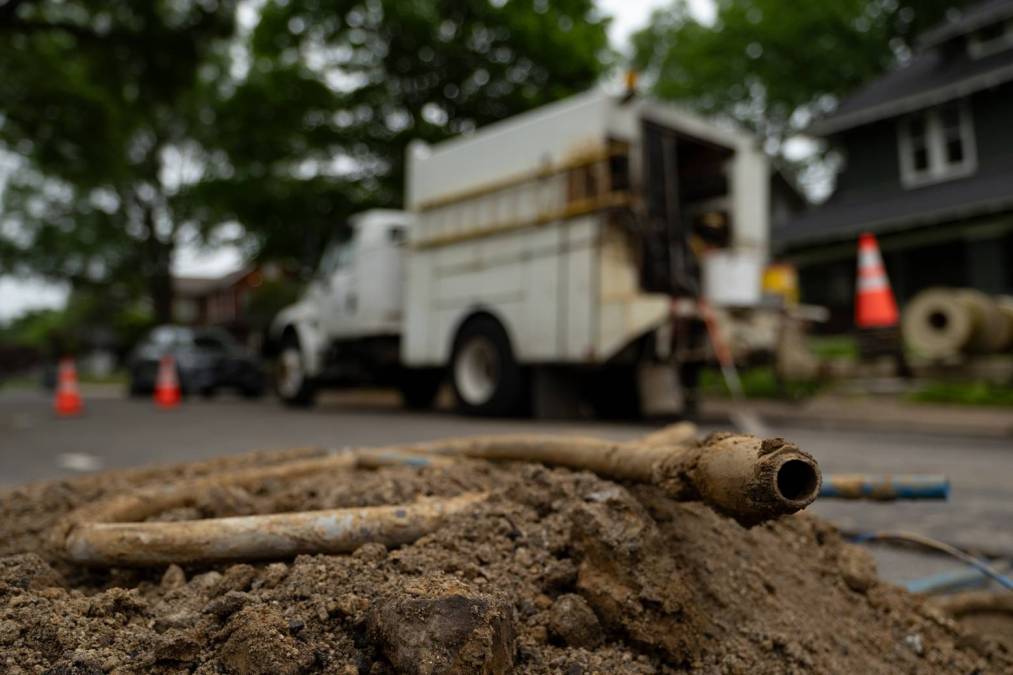Water utilities are finally finding where all the lead pipes are

The Environmental Protection Agency estimates there are 9.2 million lead pipes delivering water to homes, schools, businesses and public spaces across the United States, but starting Wednesday, the public will at least have a better idea of where more of them are located.
Wednesday marks a deadline set by the EPA in 2021 for water systems to report inventories of their service lines, making special note of those made of lead, copper or galvanized steel. Hunts for hazardous materials have been added work for water systems over the last three years, particularly those that serve large populations, though some have purchased software and conducted data analyses to aid in the task.
One of the 153,000 public drinking water systems that’s been checking its pipes is Santa Clarita Valley Water, which serves approximately 300,000 people in the northern Los Angeles suburb of Santa Clarita. Ryan Bye, its water systems supervisor, told StateScoop the agency didn’t find any lead during its inventory, but that he initially thought checking roughly 75,000 service connections was going to be “a huge, monumental task.”
Bye said his agency already had map data on hand for many of its own lines, but that it was missing data for the materials installed inside homes and businesses. Jenny Anderson, a water quality specialist with the utility, said the process was made less onerous by relying on a data analysis.
Many of the young region’s homes were built after 1986, the year Congress amended the Safe Drinking Water Act to outlaw the use of lead pipes or fixtures in water systems or new plumbing. Anderson said that by combining the agency’s map data and records of when structures were built, staff were able to drive out and check just 1,070 service lines to verify the agency’s statistical analysis.
“We were very fortunate that a lot of our homes out here were built after 1986 and newer development, so it really did drop the unknowns to about 25,000,” she said.
To manage the inventory and simplify the reporting process, Bye said the water system used software from a company called 120Water, which also sells lead-testing kits.
“Some of the pipe type we didn’t have to investigate because we sorted out homes based on year built,” he said, “but anything prior to the lead regulations we did have to find that service line material on the customer side.”
Megan Glover, 120Water’s co-founder and chief executive, told StateScoop her products are used by water agencies in 12 states, reaching 250,000 service locations. She said when she co-founded the company in 2016, she was motivated in part by the Flint, Michigan, water crisis, in which the city’s drinking water was contaminated with lead and deadly bacteria.
The incident’s national news coverage highlighted a hidden danger that’s been harming countless people for years. One 2021 study estimated that about half of the U.S. population had during childhood been exposed to adverse levels of lead, an event that has been linked with brain damage, slowed development, behavioral health issues and hearing and speech impairment.
“Every single state in the U.S. has aging infrastructure they’re going to have to address,” Glover said.
Her company’s software is designed to aid with the gigantic project of reporting more data to the EPA and the public. Water authorities serving at least 55,000 customers are additionally required to publish the findings of their inventories online.
But the Wednesday deadline is only one in a series of deadlines to come, as water authorities set out to replace outdated lines and validate their work until all the lead and other harmful materials are gone. President Joe Biden’s administration set a goal to replace every lead service line in the country within a decade, a project that’s been boosted by $2.6 billion for drinking water upgrades and service line replacement included in the 2021 bipartisan infrastructure bill.
Not all water agencies need to rely on such sophisticated means of analysis. Fabian Heaney, general manager of the Red River Authority of Texas, which serves roughly 10,000 people in rural communities stretching across the northern part of the state, said conducting his inventory of 4,099 service lines took “several months” and was “an undertaking,” but not an unmanageable one.
His investigation yielded one lead service line owned by the water authority, and nine lead lines owned by customers, who are notified so that they may choose to replace them at their own expense.
But Southern California and Northern Texas aren’t where most of the lead pipes are. A map published by the Natural Resources Defense Council shows they’re in places like Denver, Colorado; Orlando, Florida; and the Rust Belt: Chicago, Cleveland, Detroit, Milwaukee and New York City.
Heaney said the water systems under his authority run monthly tests to check for microorganisms to ensure their water is safe to drink, and that the federal mandate to find lead is similarly important.
“A lot of people have an idea that treated water is just pure, but they really don’t understand that it’s treated to a certain level of purity. There’s always going to be some type of contaminants in it, but to the extent you can take those out, yes, you want to do the best that you can do,” he said. “I don’t want anybody to get sick just because we made some error we could have easily avoided. That is of prime importance.”



